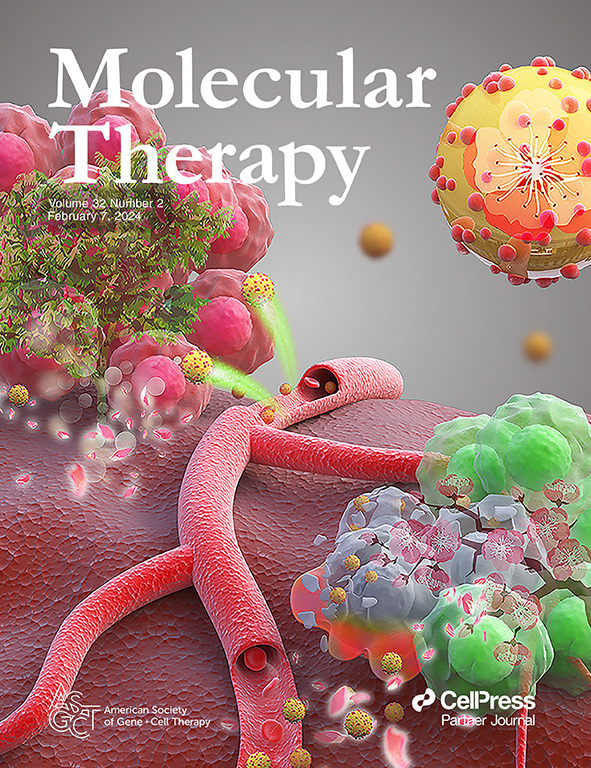Extracellular Vesicles-Associated AAVs for the treatment of Machado-Joseph Disease.
IF 12
1区 医学
Q1 BIOTECHNOLOGY & APPLIED MICROBIOLOGY
引用次数: 0
Abstract
Machado-Joseph disease (MJD) is the most common dominant autosomal inherited ataxia worldwide, caused by the over-repetition of the trinucleotide CAG in the ATXN3 gene. This leads to the accumulation of ataxin-3 protein and neurodegeneration. Currently, treatment remains symptomatic, though gene therapy has emerged as a promising approach. However, efficient and minimally invasive delivery to the brain remains a challenge. Extracellular vesicle-associated adeno-associated vectors (EV-AAVs) are a novel delivery system, combining AAVs' ability to deliver genes with extracellular vesicles' capacity to bypass the immune system and cross the blood-brain barrier (BBB). Previous studies, however, have only combined AAV serotypes known to efficiently cross the BBB with EVs as a non-invasive delivery system to the brain. Thus, the ability of EV-AAVs to cross the BBB remained inconclusive. In this study we evaluated whether AAV1/2 serotype, combined with rabies virus glycoprotein (RVg)-coated EVs, could effectively target the brain. Two isolation methods, differential ultracentrifugation and size exclusion chromatography (SEC) were compared, with SEC yielding higher EV recovery. Moreover, RVg-EV-AAV1/2 successfully crossed the BBB and transduced mouse brains, leading to motor and neuropathological improvements in an MJD mouse model. This study demonstrates that RVg-EV-AAVs are promising non-invasive delivery systems for MJD gene therapy.细胞外小泡相关aav治疗Machado-Joseph病。
Machado-Joseph病(MJD)是世界范围内最常见的显性常染色体遗传性共济失调,由ATXN3基因中三核苷酸CAG的过度重复引起。这会导致ataxin-3蛋白的积累和神经变性。目前,尽管基因治疗已经成为一种有希望的方法,但治疗仍然是对症的。然而,高效和微创的脑部移植仍然是一个挑战。细胞外囊泡相关腺相关载体(ev - aav)是一种新型的递送系统,结合了aav递送基因的能力和细胞外囊泡绕过免疫系统和穿过血脑屏障(BBB)的能力。然而,之前的研究仅将已知能有效穿过血脑屏障的AAV血清型与ev结合起来,作为一种非侵入性的大脑递送系统。因此,ev - aav穿越血脑屏障的能力仍不确定。在这项研究中,我们评估了AAV1/2血清型与狂犬病毒糖蛋白(RVg)包被的ev是否能有效靶向大脑。比较了差示超离心法和隔离层析法两种分离方法,发现隔离层析法的EV回收率较高。此外,RVg-EV-AAV1/2成功穿过血脑屏障并转导小鼠大脑,导致MJD小鼠模型的运动和神经病理改善。本研究表明,rvg - ev - aav是一种很有前途的MJD基因治疗的非侵入性递送系统。
本文章由计算机程序翻译,如有差异,请以英文原文为准。
求助全文
约1分钟内获得全文
求助全文
来源期刊

Molecular Therapy
医学-生物工程与应用微生物
CiteScore
19.20
自引率
3.20%
发文量
357
审稿时长
3 months
期刊介绍:
Molecular Therapy is the leading journal for research in gene transfer, vector development, stem cell manipulation, and therapeutic interventions. It covers a broad spectrum of topics including genetic and acquired disease correction, vaccine development, pre-clinical validation, safety/efficacy studies, and clinical trials. With a focus on advancing genetics, medicine, and biotechnology, Molecular Therapy publishes peer-reviewed research, reviews, and commentaries to showcase the latest advancements in the field. With an impressive impact factor of 12.4 in 2022, it continues to attract top-tier contributions.
 求助内容:
求助内容: 应助结果提醒方式:
应助结果提醒方式:


